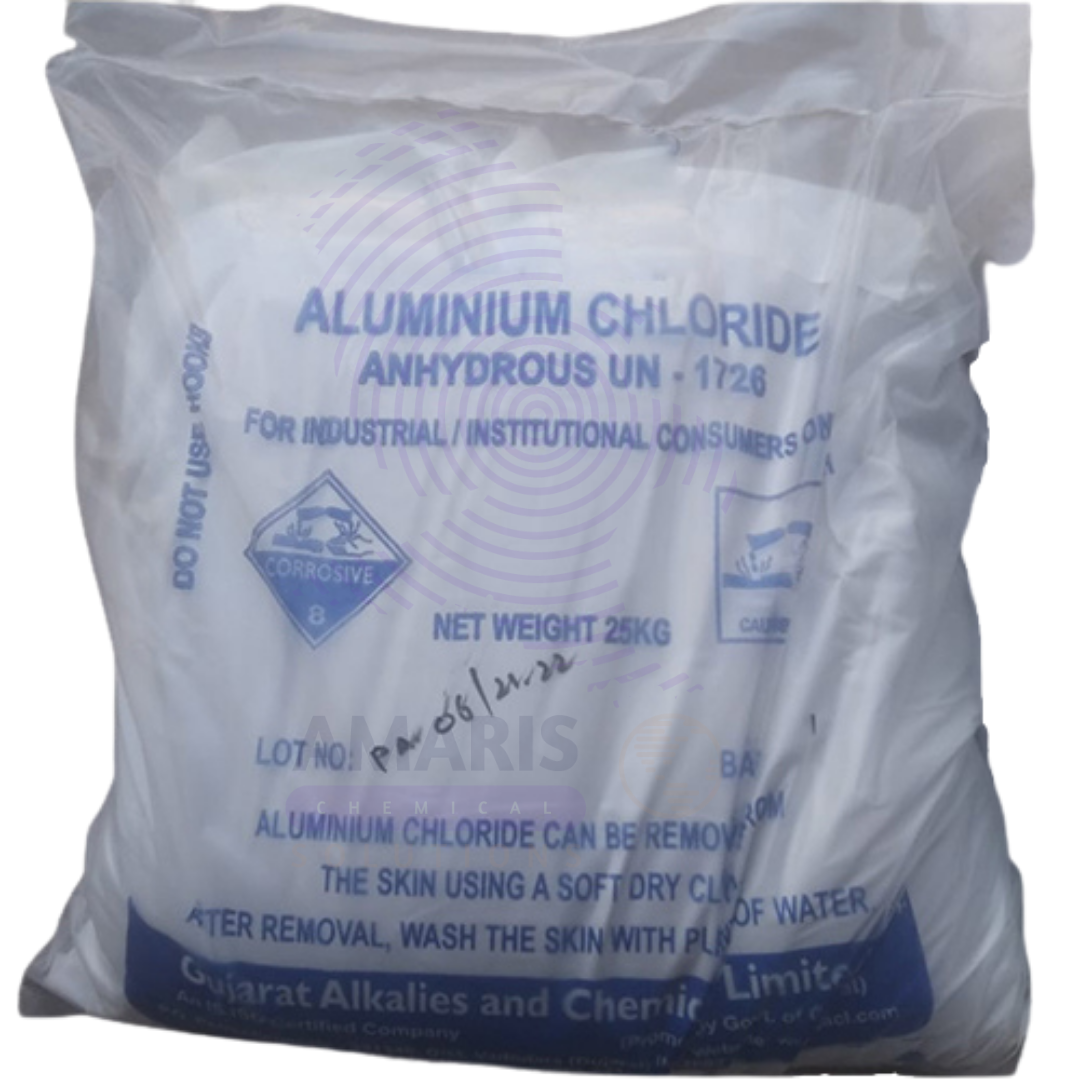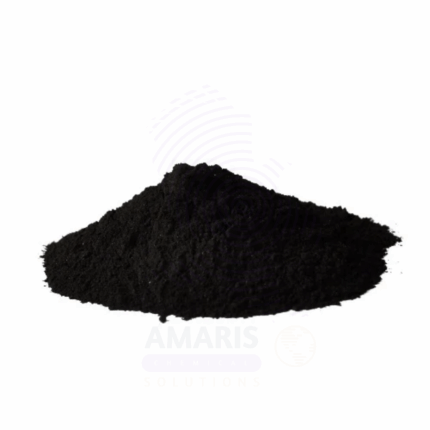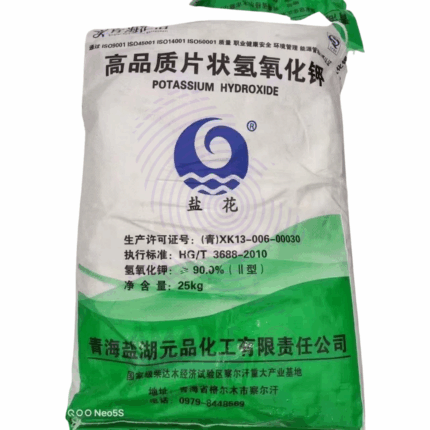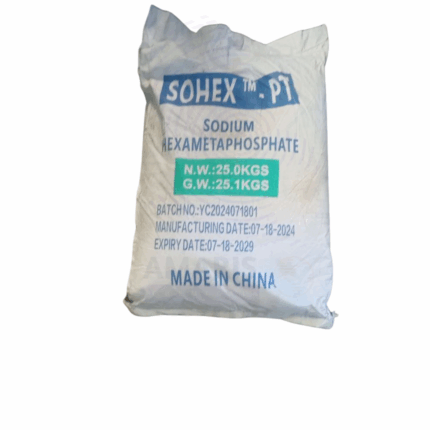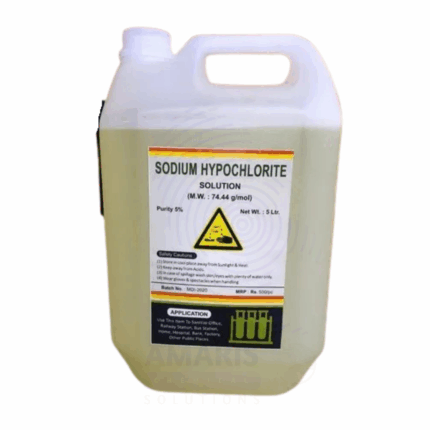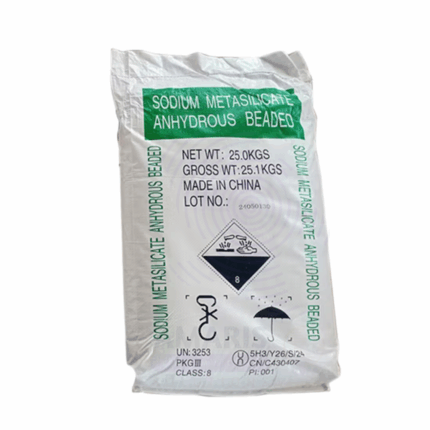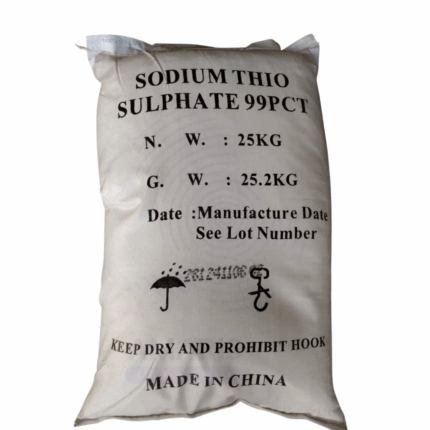Anhydrous Aluminum Chloride
$ 8.00 Original price was: $ 8.00.$ 7.63Current price is: $ 7.63.
Whatsapp Order
Anhydrous Aluminum Chloride (AlCl₃) is a white to pale yellow crystalline solid known for its strong Lewis acid properties. It is a key catalyst widely used in organic synthesis, especially in Friedel-Crafts alkylation and acylation reactions. Due to its high reactivity with moisture, it must be stored and handled under strictly anhydrous conditions. Anhydrous Aluminum Chloride also finds applications in polymerization, pharmaceuticals, and the production of dyes, pharmaceuticals, and petrochemicals.
Categories: Catalysts, Coagulants and Flocculants, COSMETIC AND PERSONAL CARE CHEMICALS, Electronic Chemicals, Preservatives, SPECIALTY AND FINE CHEMICALS, WATER TREATMENT CHEMICALS
Tags: Aluminum chloride, Anhydrous aluminum chloride, Catalyst in organic synthesis, Chemical manufacturing reagent, Pharmaceutical intermediate, Polymerization catalyst
Description
Table of Contents
Toggle
Anhydrous Aluminum Chloride
Primary Uses
- Catalyst in Chemical Industry
- Widely used as a Lewis acid catalyst in Friedel-Crafts reactions for alkylation, acylation, and polymerization of aromatic hydrocarbons.
- Essential in the production of detergents, fragrances, dyes, and pharmaceuticals.
- Petrochemical Processing
- Used in catalytic cracking and isomerization processes to improve fuel quality.
- Organic Synthesis
- Facilitates complex organic transformations such as chlorination, sulfonation, and polymerization.
Secondary Uses
- Pharmaceuticals
- Intermediate in manufacturing certain drugs and active pharmaceutical ingredients.
- Electronics & Materials Science
- Employed in etching and surface treatment of metals.
- Water Treatment
- Sometimes used in wastewater treatment as a coagulating agent (less common than hydrated forms).
PRODUCT KEY FEATURES
- Basic Identification Attributes
- Chemical Name (IUPAC): Aluminum trichloride
- Common/Trade Name: Anhydrous Aluminum Chloride, Aluminum trichloride
- CAS Number: 7446-70-0
- HS Code: 2827.39.10
- Molecular Formula: AlCl₃
- Synonyms:
- Aluminum chloride anhydrous
- AlCl3
- Aluminum(III) chloride
- Physical & Chemical Properties
- Physical State: Crystalline solid (flakes, powder, or lumps)
- Color & Odor: White to pale yellow, pungent odor when moist
- Melting Point: 192.4°C (sublimes at higher temperatures)
- Boiling Point: 180°C (sublimes)
- Density: ~2.48 g/cm³
- Solubility: Reacts violently with water, forming hydrochloric acid and aluminum hydroxide; soluble in carbon disulfide and some organic solvents
- pH Level: Reacts to form acidic solutions on hydrolysis
- Vapor Pressure: Significant at elevated temperature due to sublimation
- Flash Point: Non-flammable
- Autoignition Temperature: N/A
- Reactivity: Highly reactive, especially with moisture and water
- Safety & Hazard Attributes
- Hazard Class (GHS): Corrosive, causes severe skin burns and eye damage; reacts violently with water
- NFPA Ratings: Health 3, Flammability 0, Reactivity 2
- Exposure Limits: OSHA PEL = 2 mg/m³ (as AlCl₃), ACGIH TLV similar
- Reactivity: Reacts violently with water, releasing heat and corrosive HCl gas
- Incompatibilities: Water, moisture, strong bases, oxidizers
- Storage & Handling Attributes
- Storage Conditions: Store in a tightly sealed container under dry, inert atmosphere (e.g., nitrogen) away from moisture and humidity
- Container Type: Corrosion-resistant containers such as glass, plastic-lined steel drums
- Shelf Life: Stable if stored properly in moisture-free conditions
- Special Handling: Use in dry environments with moisture control; handle under fume hood or well-ventilated area; PPE required (gloves, goggles, respirator)
- Regulatory & Compliance Attributes
- Regulatory Status: Classified as hazardous chemical; complies with OSHA, REACH, and other chemical safety regulations
- Transportation: Classified as corrosive material (UN 2920) with special packaging and labeling requirements
- Waste Disposal: Dispose according to hazardous waste regulations; neutralize before disposal
- Environmental & Health Impact
- Ecotoxicity: Harmful to aquatic life due to acidity and aluminum ion release
- Persistence: Decomposes in water but aluminum ions may persist
- Carcinogenicity/Mutagenicity: Not classified as carcinogenic; corrosive effects predominate
- Biodegradability: Not applicable (inorganic salt)
SAFETY HANDLING PRECAUTIONS
-
Safety Handling Precautions
- PPE: Wear acid-resistant gloves, chemical safety goggles, face shield, and protective clothing. Use NIOSH-approved respirators when dust or fumes are present.
- Handling: Avoid contact with moisture or water; handle in dry, well-ventilated areas or fume hoods. Prevent dust formation.
- Storage: Store in airtight containers, in cool, dry areas away from incompatible substances like water or bases.
- Hygiene: Wash thoroughly after handling; do not eat, drink, or smoke while using the chemical.
- Spill Handling: Avoid dust generation; use inert absorbents and neutralize spills with lime or sodium bicarbonate cautiously.
First Aid Measures
- Inhalation: Move to fresh air immediately; administer oxygen if breathing is difficult; seek medical attention urgently.
- Skin Contact: Remove contaminated clothing; wash affected area with plenty of water for at least 15 minutes; seek medical attention.
- Eye Contact: Rinse eyes immediately with plenty of water for at least 15 minutes; seek urgent medical care.
- Ingestion: Do not induce vomiting; rinse mouth and seek emergency medical care immediately.
Firefighting Measures
- Fire Hazards: Not flammable but reacts violently with water releasing corrosive HCl gas and heat.
- Extinguishing Media: Use dry chemical powder, sand, or special Class D extinguishers; DO NOT use water.
- Special Precautions: Firefighters must wear full protective gear and self-contained breathing apparatus (SCBA) due to toxic fumes.
- Preventive Actions: Avoid exposure to moisture and maintain good ventilation.
Related products
Mono Ethanol Amine
Mono Ethanol Amine (MEA) is a clear, colorless, hygroscopic liquid with an ammonia-like odor. It is an organic chemical compound combining both amine and alcohol functional groups. MEA is widely used as a versatile chemical intermediate and is especially important in gas treatment, detergents, and chemical manufacturing due to its alkalinity and solubility in water and organic solvents.
Potassium Hydroxide
Potassium Hydroxide is a highly concentrated, caustic alkaline chemical available as a solid (pellets, flakes) or concentrated aqueous solution. It is a strong base widely used in industrial processes, chemical manufacturing, and as a reagent. Potassium Hydroxide provides excellent neutralizing, saponifying, and cleaning properties and is essential in producing potassium soaps, biodiesel, fertilizers, and various chemical compounds. Its high purity and concentration (90%) make it suitable for demanding applications requiring strong alkalinity.
Sodium Hexametaphosphate Food Grade
Sodium Hexametaphosphate Food Grade is a white, granular or powdery inorganic compound composed of sodium and metaphosphoric acid polymers. It is highly soluble in water and acts as an effective sequestrant, dispersing agent, and water softener. SHMP is widely used across various industries including food processing, water treatment, detergents, ceramics, and metallurgy. It helps control hardness, prevent scale formation, and stabilize formulations, making it valuable in both industrial and consumer applications.
Sodium Hypochlorite
Sodium Hypochlorite 10-12% (commonly known as Jik) is a clear to pale greenish-yellow liquid with a strong chlorine odor. It is a widely used disinfectant and bleaching agent, known for its powerful oxidizing properties. This grade is commonly employed in household cleaning, water treatment, and industrial sanitation processes. It is effective against a broad spectrum of microorganisms, making it a popular choice for disinfection and sterilization.
Sodium Metasilicate Anhydrous
Sodium Metasilicate Anhydrous is a white crystalline solid known for its alkaline properties and high solubility in water. It is widely used in industrial cleaning, detergent formulations, water treatment, and as a corrosion inhibitor. The anhydrous form is preferred where moisture sensitivity is a concern. It acts as a strong alkaline builder, improving the effectiveness of detergents and degreasers. This product is also used in adhesives, cement, and ceramics due to its binding and strengthening properties.
Sodium Nitrite
Sodium Nitrite is an inorganic white to slightly yellowish crystalline powder with the chemical formula NaNO₂. This versatile chemical serves as a powerful reducing agent, corrosion inhibitor, and food preservative, widely used in meat curing, pharmaceutical synthesis, and industrial applications. Its oxidative properties make it valuable for dye manufacturing and rubber processing while requiring careful handling due to its toxicity.
Sodium Thiosulphate
Sodium Thiosulphate (Na₂S₂O₃) is a white, crystalline, odorless powder or granular solid highly soluble in water. This 25kg packaged chemical is widely used in photographic processing, water treatment, chemical synthesis, and medicine. Known for its reducing and complexing properties, it acts as an effective dechlorinating agent and fixer in photography by dissolving silver halides. It is stable under normal conditions and easily handled for industrial and laboratory applications.
Sulphonic Acid (LABSA) 90%
Sulphonic Acid, commonly known as Linear Alkyl Benzene Sulphonic Acid (LABSA) 90%, is a high-quality anionic surfactant widely used as a key raw material in the detergent and cleaning products industry. It is produced by sulfonation of linear alkyl benzene, resulting in a biodegradable, highly effective wetting and foaming agent. The 90% concentration grade offers excellent performance in formulation of powders, liquids, and specialty detergents.


 Preservatives(food)
Preservatives(food) Flavor Enhancers
Flavor Enhancers Acidulants
Acidulants Sweeteners
Sweeteners Antioxidants
Antioxidants Colorants(food)
Colorants(food) Nutraceutical Ingredients (food)
Nutraceutical Ingredients (food) Nutrient Supplements
Nutrient Supplements Emulsifiers
Emulsifiers
 Collectors
Collectors Dust Suppressants
Dust Suppressants Explosives and Blasting Agents
Explosives and Blasting Agents Flocculants and Coagulants
Flocculants and Coagulants Frothers
Frothers Leaching Agents
Leaching Agents pH Modifiers
pH Modifiers Precious Metal Extraction Agents
Precious Metal Extraction Agents
 Antioxidants(plastic)
Antioxidants(plastic) Colorants (Pigments, Dyes)
Colorants (Pigments, Dyes) Fillers and Reinforcements
Fillers and Reinforcements Flame Retardants
Flame Retardants Monomers
Monomers Plasticizers
Plasticizers Polymerization Initiators
Polymerization Initiators Stabilizers (UV, Heat)
Stabilizers (UV, Heat)
 Antifoaming Agents
Antifoaming Agents Chelating Agents
Chelating Agents Coagulants and Flocculants
Coagulants and Flocculants Corrosion Inhibitors
Corrosion Inhibitors Disinfectants and Biocides
Disinfectants and Biocides Oxidizing Agents
Oxidizing Agents pH Adjusters
pH Adjusters Scale Inhibitors( water)
Scale Inhibitors( water)
 Antioxidants(cosmetic)
Antioxidants(cosmetic) Emollients
Emollients Fragrances and Essential Oils
Fragrances and Essential Oils Humectants
Humectants Preservatives
Preservatives Surfactants(cosmetic)
Surfactants(cosmetic) Thickeners
Thickeners UV Filters
UV Filters
 Fertilizers
Fertilizers Soil Conditioners
Soil Conditioners Plant Growth Regulators
Plant Growth Regulators Animal Feed Additives
Animal Feed Additives Biostimulants
Biostimulants Pesticides (Herbicides, Insecticides, Fungicides)
Pesticides (Herbicides, Insecticides, Fungicides)
 Active Pharmaceutical Ingredients (APIs)
Active Pharmaceutical Ingredients (APIs) Excipients
Excipients Solvents(pharmaceutical)
Solvents(pharmaceutical) Antibiotics
Antibiotics Antiseptics and Disinfectants
Antiseptics and Disinfectants Vaccine Adjuvants
Vaccine Adjuvants Nutraceutical Ingredients (pharmaceutical)
Nutraceutical Ingredients (pharmaceutical) Analgesics & Antipyretics
Analgesics & Antipyretics
 Analytical Reagents
Analytical Reagents Solvents(lab)
Solvents(lab) Chromatography Chemicals
Chromatography Chemicals Spectroscopy Reagents
Spectroscopy Reagents microbiology-and-cell-culture-reagents
microbiology-and-cell-culture-reagents Molecular Biology Reagents
Molecular Biology Reagents Biochemical Reagents
Biochemical Reagents Inorganic and Organic Standards
Inorganic and Organic Standards Laboratory Safety Chemicals
Laboratory Safety Chemicals Specialty Laboratory Chemicals(Special Laboratory Equipment)
Specialty Laboratory Chemicals(Special Laboratory Equipment)
 Demulsifiers
Demulsifiers Hydraulic Fracturing Fluids
Hydraulic Fracturing Fluids Scale Inhibitors(oil)
Scale Inhibitors(oil) Surfactants(oil)
Surfactants(oil) Drilling Fluids
Drilling Fluids
 Dyes and Pigments
Dyes and Pigments Bleaching Agents
Bleaching Agents Softening Agents
Softening Agents Finishing Agents
Finishing Agents Antistatic Agents
Antistatic Agents
 Admixtures
Admixtures Waterproofing Agents
Waterproofing Agents Sealants and Adhesives
Sealants and Adhesives Curing Compounds
Curing Compounds Concrete Repair Chemicals
Concrete Repair Chemicals Anti-Corrosion Coatings
Anti-Corrosion Coatings
 Surfactants(cleaning)
Surfactants(cleaning) Builders
Builders Enzymes
Enzymes Solvents (Cleaning)
Solvents (Cleaning) Fragrances
Fragrances
 Electronic Chemicals
Electronic Chemicals Catalysts
Catalysts Lubricants
Lubricants Photographic Chemicals
Photographic Chemicals Refrigerants
Refrigerants Automotive chemicals
Automotive chemicals Pyrotechnic Chemicals
Pyrotechnic Chemicals
 Biodegradable Surfactants
Biodegradable Surfactants Bio-based Solvents
Bio-based Solvents Renewable Polymers
Renewable Polymers Carbon Capture Chemicals
Carbon Capture Chemicals Wastewater Treatment Chemicals
Wastewater Treatment Chemicals
 Pigments
Pigments Solvents(paint)
Solvents(paint) Specialty Coatings
Specialty Coatings Binders/Resins
Binders/Resins Additives
Additives Driers
Driers Anti-Corrosion Agents
Anti-Corrosion Agents Functional Coatings
Functional Coatings Application-Specific Coatings
Application-Specific Coatings
 Fresh Herbs
Fresh Herbs Ground Spices
Ground Spices Whole Spices
Whole Spices Spice Blends
Spice Blends Dried Herbs
Dried Herbs
 Leavening Agents
Leavening Agents Dough Conditioners
Dough Conditioners Flour Treatments
Flour Treatments Fat Replacers
Fat Replacers Decoratives
Decoratives Preservatives(baking)
Preservatives(baking)
 Plasticizers & Softeners
Plasticizers & Softeners Reinforcing Agents
Reinforcing Agents Adhesion Promoters
Adhesion Promoters Vulcanizing Agents
Vulcanizing Agents Antidegradants
Antidegradants Blowing Agents
Blowing Agents Fillers & Extenders
Fillers & Extenders Accelerators & Retarders
Accelerators & Retarders